| DISEASE RESISTANT ANNUAL VINCA (PERIWINKLE)
DEER RESISTANT, SEMI-SHADE TOLERANCE
DROUGHT-TOLERANT NAMED
*CORA* OR *NIRVANA*
TM
written by
Jerry M. Parsons, Professor & Extension Horticulturist
Texas AgriLife Extension Service
San Antonio, Texas
Edited by
Larry Barnes, Professon and Extension Plant Pathologist
Texas AgriLife Extension Service
College Station, Texas
Brent Pemberton, Professor and Research Horticulturist
Texas AgriLife Research The Overton Research and Extension Center
HAVE YOU EVER SEEN, HEARD OR EXPERIENCED THE FOLLOWING:
Question: What does the annual Vinca/Periwinkle plant look like
once it has been infected with the Aerial Phytophthora fungus
and is there anything you can do to help once you have the fungus?
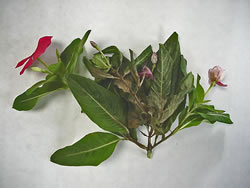
Phytophthora on annual Vinca or Periwinkle |
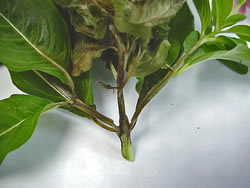
The stems of an infected plant with Phytophthora simply
shrivel
away. |
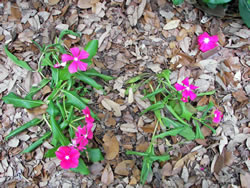
Annual Vinca foliage with Phytopthera wilts as if the plant
needs
watering. |
Answer: As can be seen from these images, the stem turns black
and the plant above the lesion will gradually die. When you see
this symptom on a plant you should remove it from the bed and
discard it in the garbage. You should not plant the Annual Vinca/Periwinkle
until the weather gets hot (late May - June); you should mulch
around the plants to help prevent the soil particles where the
disease is residing from splashing up onto the plants; and you
should water the soil and never the plants.
From: http://www.plantanswers.com/Phytophthora.htm Annual Vinca
(periwinkle): If full sun conditions prevail, periwinkle can be
used. It will also perform well in partial shade. Annual Vinca
(periwinkle) should not be confused with the perennial groundcover
of the same name. Flowers of pink, white or violet are often highlighted
with a contrasting red eye. This is one of a very few annual flowers
which the deer won't destroy.
QUESTION: Is the fungus that infects the annual periwinkle plant
specific to the annual periwinkle plant only? Once a bed is infested
with it, does the fungus remain in the soil forever? Well, maybe
not forever, but for several years. Are there precautions that
should be taken for other plants in the same bed such as trees
and shrubs.
ANSWER: Most other plants should be okay. Potential problems
might develop with other bedding plants such as snapdragons, stocks,
petunia, pansy, viola, etc. However, Phytophthora fungi are most
happy if soil is waterlogged due to planting in a well, over watering,
poor surface and internal drainage, etc. Therefore, amend soil,
throw up mound/berm, and water in moderation, avoid sprinklers.
There was a paper at the August, 1999 APS meeting on this based
on work in Hawaii. They found that at least three Phytophthora
species infected periwinkle, all with similar symptoms. Their
most common species, and what we see most often in Texas, is P.
nicotianae.
NOW!!!! Are you ready for a minor miracle? Are you ready for
another *break-through* thanks to a Plant Pathologist Specialist
at Texas A&M University working for the Texas AgriLife Extension
Service? Well, whether you are ready or not, a big one has happened!!
For about 10 years now, everyone was scared to death to plant
annual Vinca (Perwinkle) because of the plant-killing disease
named Aerial Phytophthora (fungus - Phytophthora parasitica):
The infection is generally characterized by leaf blight and upper
stem deterioration. Infection is distinctly an aerial problem,
not involving lower stem and root tissue. In most cases, leaves
are shriveled and dull-gray in color. An aerial sunken stem canker
can also develop. Symptoms develop rapidly in outdoor planted
beds, especially during conditions of prolonged, rainy weather.
This is a soil borne fungal disease that, once in the plant, will
eventually kill the entire plant. There is no cure for it. There
are, however, some preventative measures that you can take to
help prevent it. First, annual periwinkles should not be planted
until the soil and air temperature get quite warm. It is normally
recommended that you wait until the last of May - first of June
to plant them. Secondly, you should place mulch around your plants
to help prevent the splashing of the spores up on the plants.
And lastly, the plants should be watered from the bottom using
drip irrigation or a bubbler emitter on your sprinkler system.
NOW!!! FINALLY!!! You can reap the rewards of a deer-resistant,
disease-resistant, shade-or-sun exposure, summer-through-fall,
spectacular blooming annual. Here is the story.
In the spring of 2007, Dr. Brent Pemberton, Texas AgriLife Research
horticulturist working at the Overton Center, provided the Texas
SuperStar plant evaluation team with sample plants of annual Vinca
which he said were disease resistant. Dr. Jerry Parsons, Texas
AgriLife Extension Service horticulturist in San Antonio was skeptical
to say the least. Dr. Pemberton even wanted to provide a check
variety which was known to be highly susceptible. Parsons explained
to him that if it could live a month ANYWHERE in San Antonio,
it would be a breakthrough-he didn*t need a check variety because
every annual Vinca/Periwinkle in San Antonio suffered from the
disease.
Forrest Appleton, the famous deer-handler (i.e., keeping deer
from eating every plant in the landscape! See: http://aggie-horticulture.tamu.edu/plantanswers/publications/deerbest.html)
of Hollywood Park had expressed an interest in trying to plant
some more annual Vinca/Periwinkle in an area which had not had
the disease-thinking that would prevent or lessen the disease
pressure on the plants. He had several beds which were heavily
contaminated from past years of planting annual Vinca/Periwinkle.
The reason everyone with a deer problem desperately need annual
Vinca/Periwinkle is that (1) deer will not touch them, (2) the
plants do well in semi-shade or full-sun, and (3) many colors
are available and the plants will bloom profusely until the first
hard frost after planting in June.--- 6 months of beauty!!.
The results were UNBELIEVABLE!!!! During the fourth wettest spring
and early summer in San Antonio weather-keeping history!!, not
a one of these plants died of the disease. These plants were planted
in the contaminated beds rather than *clean* beds. The deer walked
all around the flowers and did not touch a one!
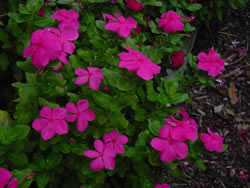
'Nirvana's at Hollywood Park, Texas |
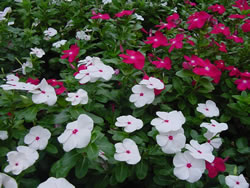
'Cora's at Hollywood Park, Texas |
Parsons was surprised by this performance because he could not
imagine that disease resistance existed in annual Vinca/Periwinkle.
Parsons requested that Brent Pemberton try to find where this
resistant originated. So Brent wrote to Mark Seguin of Fischer
Plants. Brent wrote: *The Nirvana annual Vinca/Periwinkle did
very well in our trials this year (*07) despite all of the rain
and high disease pressure. They are very strong contenders for
a Texas Superstar Promotion. We will probably trial them one more
year across the state with a promotion in 2009. Could you send
me some information about them such as history, sources of resistance,
future colors, etc.?*
Mark Seguin of Fischer Plants wrote: *We are glad to hear the
Nirvanas are living up to their reputation. Goldsmith Seeds, Inc.
discovered and characterized the genetic resistance to aerial
Phytophthora in their annual Vinca/Periwinkle breeding germplasm
nearly two decades ago. They obtained a utility patent on the
trait and used it as the foundation for their annual Vinca/Periwinkle
breeding program. After fourteen years of development, the Nirvana
and Nirvana Cascade annual Vinca/Periwinkle were introduced as
the first products with this unique and superior genetic resistance.*
*Nirvana annual Vinca/Periwinkle is likely to remain a market
leader in the future; even while improved seed varieties enter
the market (Goldsmith is introducing *Cora* annual Vinca/Periwinkle
from seed). The vegetatively produced Nirvana's are available
in 18 different varieties (9-Uprights and 9-Cascading types) and
offer the largest flowers on the market. Future emphasis is being
placed on novel color patterns (e.g., Nirvana Pink Splash) and
colors that are difficult to produce from seed.*
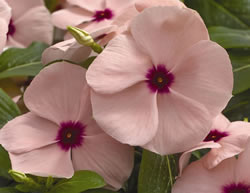
'Nirvana' Apricot |
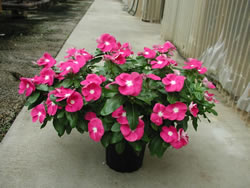
Vinca 'Nirvana' Rasberry with eye |
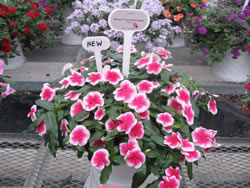
'Nirvana' Cascade Pink Splash |
Brent Pemberton then corresponded with Ryan O*Callaghan at Goldsmith
Seed Company about *Cora* annual Vinca/Periwinkle. He said: *The
*Nirvanas* were introduced first as a vegetative line because
they could be put on the market faster than developing a seed
strain. The *Cora's* are the seed strain from the *Nirvanas* which
still have some novel colors and plant habits. Two new *Cora*
colors will be introduced this spring (*08). *Cora* is named after
Cora Van Wingerden - the matriarch of one of the largest horticulture
families in the country.
Parsons writes: Concerning the annual Vinca/Periwinkle, guess
where the resistance of this line was first tested?!?!? At College
Station, Texas, working with Dr. Larry Barnes at Texas A&M
University!!! Larry was working with Dr. Darrell Thomas, plant
pathologist at Goldsmith Seed. ALL of the so-called *resistant*
varieties of annual Vinca were planted side-by-side in a randomized,
replicated (six reps) design-this simply means all of the annual
Vinca varieties being tested were randomly selected and planted
side-by-side in each of six different - yet adjoining-blocks.
This type of planting insures no coincidental findings, i.e.,
if a variety performs the same in ALL four blocks, you can be
more assured of the results. This image shows the planting in
its full glory!!!
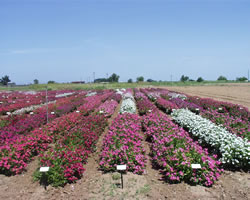
So-called resistant annual Vinca varieties planted in College
Station, Texas, in 2000
Researchers can not depend on the chance that the plant being
tested will definitely be contacted with spores of the Phytophthora
nicotianae species. To insure every annual Vinca variety has the
*opportunity* to exhibit its resistant, Dr. Barnes grew the Phytophthora
nicotianae fungus in the laboratory and infested the soil in the
test area so that all the plants (which were thought to be resistant
to the disease) would be exposed to the fungus. The results are
recorded in this image:
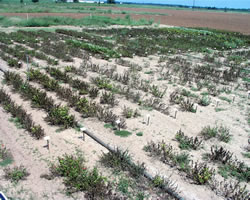
Annual Vinca survivors after treatment
EVERY ONE of the inoculated varieties DIED except ONE!! A single,
white selection which had resistance was identified in EVERY block-see
red arrows in the last image. The following image shows the ONLY
survivor (that white one next to the DEAD ONES) in these replicated
plantings.
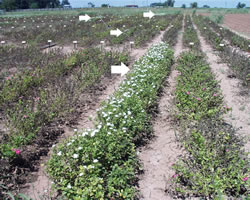
Source of resistance is white (arrows pointing to it in each
replication) annual Vinca.
After this test, Goldsmith Seed Company got the resistant genetics
from this white selection. A Goldsmith representative says: *The
original germplasm was found overseas by Mr. Goldsmith himself
about 20 years ago. They have been breeding it all these years
and along the way, the disease resistant lines appeared and were
selected. They are not sure if it came from the collection overseas
or if the resistance was somewhere in the genome of the genetics
that it was crossed with, but they have a patent on the resistance
gene.* However, before this definitive test by A&M, the company
thought ALL their varieties were resistant-obviously NOT!!!!!
(see Image 10 above!)
Stands up to heat, humidity, and rain beautifully, and blooms
heavily all summer. A Breakthrough in Disease Resistance! No More
"Sudden Death" Annual Vincas!
This new Annual Vinca has been two decades in the making, the
disease-fighting technology developed for it is so revolutionary
that it's actually patented! Until now, Annual Vinca has been
prey to "sudden death" in humid, rainy, or very hot
climates. Now the cure has been discovered, and Cora* is ready
to thrive in the most damp and moist conditions without turning
a petal! It's a whole new day for this lovely, long-blooming plant!
'Cora'* Apricot is a very well-branched, heavy-blooming plant
about 14 to 16 inches high and 25 inches wide. The blooms are
a bright shade of apricot starred with a darker center, and they
appear right down to the ground. Flowering heavily all summer
(and sometimes in late spring and early fall as well!), this plant
is eye-catching and very, very easy to grow. 'Cora'* was the only
Annual Vinca to survive until frost in punishing garden trials
in Dallas. After all the freak hot spells and cold snaps of autumn,
it alone remained in the garden, briskly growing! This is a plant
that can take climate stress of all types in stride.
In addition to Apricot, there are 7 other single colors: Burgundy,
Lavender, Deep Lavender, Pink, Punch, Violet and White. Each color
has the same height, width, and bloom time as the others, so they
do very well in large mixed plantings.
Sun/Part Shade; Height: 14-16 inches, Width: 25 inches; Summer
Give Cora* full sun and good soil drainage. It is useful as a
bedding plant, border standout, ground cover, and even in containers
indoors and out!
*Cora* seed is available from Park Seed Catalog. Click here
for more information.
|



